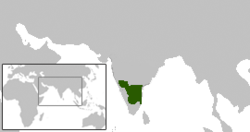帕拉瓦王朝
| 帕拉瓦王朝 | |||||||||||||||
|---|---|---|---|---|---|---|---|---|---|---|---|---|---|---|---|
| 275年—897年 | |||||||||||||||
|
国旗 | |||||||||||||||
 帕拉瓦王朝疆域(645) | |||||||||||||||
| 地位 | 王国 | ||||||||||||||
| 首都 | 建志补罗(今甘吉布勒姆) | ||||||||||||||
| 常用语言 | 梵语,普拉克里特诸语言, 淡米尔语,泰卢固语 | ||||||||||||||
| 宗教 | 印度教 | ||||||||||||||
| 政府 | 君主制 | ||||||||||||||
| 国王 | |||||||||||||||
• 275–300年 | Simhavarman I | ||||||||||||||
• 882–897年 | Aparajitavarman | ||||||||||||||
| 历史时期 | 古代 | ||||||||||||||
• 建立 | 275年 | ||||||||||||||
• 终结 | 897年 | ||||||||||||||
| |||||||||||||||
| 今属于 | |||||||||||||||
历史系列条目 |
|---|
| 印度历史 |
 |
帕拉瓦王朝(275年-897年),《旧唐书》译作拔罗婆,是古代南印度的一个王朝,在宗主国百乘王朝衰退后逐渐崛起。[2][3]首都是建志补罗(今甘吉布勒姆),统治泰卢固地区和北部淡米尔地区长达约600年。帕拉瓦王朝长期与北部巴达米地区的遮娄其人和南部的淡米尔人王国朱罗王朝、潘地亚王朝作战。最终在9世纪被朱罗击败。
帕拉瓦人以对建筑的赞助而知名,最著名的是马马拉普拉姆的海滨庙(Shore Temple)。[4]帕拉瓦人给后世留下了壮丽的建筑与雕塑,是中世纪南印度建筑艺术的基础。他们还基于古兰塔文发展出了帕拉瓦文,是东南亚诸文字的始祖。

记载
[编辑]唐高僧玄奘《大唐西域记》:“达罗毗荼国周六千余里,国大都城号建志补罗,周三十余里。土地沃壤,稼穑丰盛,多花果,出宝物。气序温暑,风俗勇烈。深笃信义,高尚博识,而语言文字,少异中印度。伽蓝百余所,僧徒万余人,皆遵学上座部法。天祠八十余所,多露形外道也。如来在世,数游此国,说法度人,故无忧王于诸圣迹皆建窣堵波。建志补罗城者,即达磨波罗菩萨本生之城。菩萨此国大臣之长子也,幼怀雅量,长而弘远。年方弱冠,王姬下降。礼筵之夕,忧心惨凄,对佛像前殷勤祈请。至诚所感,神负远遁,去此数百里,至山伽蓝,坐佛堂中。有僧开户,见此少年,疑其盗也,更诘问之。菩萨具怀指告,因请出家。众咸惊异,遂允其志。王乃宣命,推求遐迩,乃知菩萨神负远尘。王之知也,增深敬异。自染衣已,笃学精勤,令问风范,语在前记。城南不远有大伽蓝,国中聪睿同类萃止。有窣堵波,高百余尺,无忧王所建也。如来在昔于此说法,摧伏外道,广度人天。其侧则有过去四佛坐及经行遗迹之所。”[5]
历代君主
[编辑]印度学者Nilakanta Sastri整理的君王世系。[6]
早期帕拉瓦
- Simhavarman I (275–300)
- Skandavarman (unknown)
- Visnugopa (350–355)
- Kumaravishnu I (350–370)
- Skandavarman II (370–385)
- Viravarman (385–400)
- Skandavarman III (400–436)
- Simhavarman II (436–460)
- Skandavarman IV (460–480)
- Nandivarman I (480–510)
- Kumaravishnu II (510–530)
- Buddhavarman (530–540)
- Kumaravishnu III (540–550)
- Simhavarman III (550–560)
晚期帕拉瓦
- Simhavishnu (575–600)
- Mahendravarman I (600–630)
- Narasimhavarman I (Mamalla) (630–668)
- Mahendravarman II (668–672)
- Paramesvaravarman I (670–695)
- Narasimhavarman II (Raja Simha) (695–722)
- Paramesvaravarman II (705–710)
- Nandivarman II (Pallavamalla) (730–795)
- Dantivarman (795–846)
- Nandivarman III (846–869)
- Aparajitavarman (879–897)
参见
[编辑]参考文献
[编辑]- ^ Ancient Jaffna: Being a Research Into the History of Jaffna from Very Early Times to the Portuguese Period, C. Rasanayagam, p.241, Asian Educational Services 1926
- ^ The journal of the Numismatic Society of India, Volume 51, p.109
- ^ Alī Jāvīd and Tabassum Javeed. (2008). World heritage monuments and related edifices in India, p.107 [1] (页面存档备份,存于互联网档案馆)
- ^ Nilakanta Sastri, A History of South India, p139.
- ^ 《大唐西域记》(卷十)
- ^ Nilakanta Sastri, A History of South India, p.92
Text is available under the CC BY-SA 4.0 license; additional terms may apply.
Images, videos and audio are available under their respective licenses.

